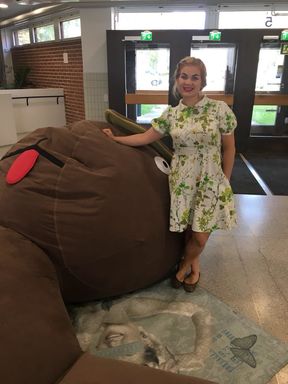Welcome to Espoo – let’s develop the community together!

This blog post was first published on AYY's old website on August 30, 2018.
Why did you come to Finland?
I’ve heard that’s the question people with foreign background are most often asked here. I’m not going to ask that. Of course you came to Finland! It’s the happiest country in the world with top quality education and a super active student culture. We have fresh air, lush nature (and snow!), room to breathe and to develop yourself. Now it’s up to you to make the most of your journey in the land of Nokia, Rovio and Junction (all from Espoo, by the way)!
I’m especially happy you chose to study in Espoo! Espoo is the second largest city in Finland (with 279,044 inhabitans, to be precise) and you’re one of the about 18,500 students in town. Innovation is a word you cannot avoid when talking about Espoo – we’re home to the biggest innovation ecosystem in Northern Europe, Espoo Innovation Garden, and we were named the Most Intelligent Community in the World in 2018. Not bad, eh?
Maybe the best thing about the innovation ecosystem in Espoo is that it’s strongly based on the idea of cooperation, peer-support and community, so don’t hesitate to get involved. Your journey into the community might start in the student organizations, continue to the startup scene, evolve to masters thesis work at one of the research organizations or companies, and before you notice, you’ve decided to stay here. All it takes is a curious mind, an active attitude, and building your networks from the day one.
Espoo is one of the most international cities in Finland – currently home to 155 different nationalities. According to estimations, the amount of foreign language speakers in Espoo will double by 2030, when we’ll have 30% of the working age population not speaking Finnish or Swedish as their mother tongue. We encourage everyone to learn Finnish or Swedish, as it makes integration into the job market and into the society much easier, but we also want it to be easy to settle down in Espoo and to use the services you are entitled to as our resident.
In 2017, the city council made the decision to introduce English as one of the languages of service in Espoo. We’re the first city in Finland to do this, and as there is no guide book for a process this size, we need your help. Please share your ideas and experiences about public services (e.g. health care, libraries, sport venues) and help us develop a city that works for everyone. The survey is open until 10.9.2018.
Kiitos paljon, and once again, a warm welcome to Espoo. we’re happy you decided to study here.
Milla Ovaska
The writer works as the Head of International Affairs in the City of Espoo and her favourite lunch spot in Otaniemi is in Dipoli. See you around!
P.S. My colleagues at VisitEspoo would get angry at me if I forgot to mention how awesome nature and culture Espoo has! National park, island hopping, museums and activity parks can all be found at www.visitespoo.fi
Read more news

Why is free education beneficial for all?
Today is the Day for Free Education. Each year it is important for us to remember that this system should not be taken for granted. We should understand its significance and why it should be preserved. In this blog, AYY’s board member Marcell Berta shares his thoughts on the topic.
Climate change conference is approaching – is students’ voice heard in decision-making?
Aalto University is sending four researchers to conference, organized in Belém, Brazil, to strengthen the scientific foundation for the negotiations. Before departing for Belém, the researchers would like to hear what kind of messages our students would like to bring to the conference. Board member Jenni Toivonen shares her thoughts.
How long have there been gay people in Otaniemi?
On Saturday, October 11, we celebrate International Coming Out Day, and in honor of the occasion, GAYY’s guest blog explores the history of LGBTQ+ student organizations in Otaniemi. Aalto University’s rainbow student association, GAYY, is familiar to many current students—but not everyone knows that it wasn’t the first rainbow association in Otaniemi. We had some glimpses of this history, but it is not very well known, even among GAYY board members. There have certainly been gay people in Otaniemi from the start, yet the first of the three rainbow associations was founded in 1996. Welcome to a journey through the history of Otaniemi’s rainbow associations!
